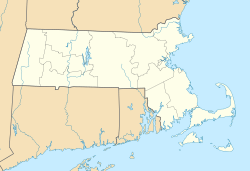Penikese Island facts for kids

Penikese Island from the southeast in 2005.
|
|
| Geography | |
|---|---|
| Coordinates | 41°27′00″N 70°55′23″W / 41.4501071°N 70.9230909°W |
| Archipelago | Elizabeth Islands |
| Total islands | 1 |
| Area | .117 sq mi (0.30 km2) |
| Highest elevation | 52 ft (15.8 m) |
| Administration | |
|
United States
|
|
| State | Massachusetts |
| County | Dukes County |
| The Elizabeth Islands |
|---|
 |
| Major Islands listed in order from east to west |
| Nonamesset Uncatena Naushon Pasque Nashawena Penikese Cuttyhunk |
| Minor Islands: |
| Bachelor Baret Bull Cedar Gosnold Gull Rock Veckatimest Weepecket Islands |
Penikese Island is a small island off the coast of Massachusetts, United States. It covers about 75-acre (0.117 sq mi) and is located in Buzzards Bay. Penikese is part of the Elizabeth Islands, which form the town of Gosnold, Massachusetts. It sits near the western end of this island chain.
Contents
Island History
Early Visitors to Penikese
Penikese Island first appeared in historical records in 1602 AD. An English explorer named Bartholomew Gosnold visited the island with some of his crew. During their visit, they met four Wampanoag Native Americans. The meeting caused the Wampanoag people to hide, and the explorers took their canoe.
The island was once covered with trees. Later, the trees were gone, and the island was used for sheep to graze. Today, it is mostly covered in grass. The island changed owners many times. Eventually, a businessman named John Anderson bought it for his vacations.
A Special School for Nature Study
In early 1873, a famous scientist named Louis Agassiz convinced John Anderson to give him the island. Anderson also gave $50,000 to start a new kind of school. This school would teach natural history. Students would learn by studying nature directly, not just from books.
The school opened in July 1873, with Louis Agassiz in charge. After he passed away in December, his son, Alexander Agassiz, took over. A fire in 1875 caused the school to close. However, some former students later opened the Marine Biological Laboratory in 1888. This new lab was in nearby Woods Hole.
Penikese Island's Hospital Era
In 1904, the state of Massachusetts bought Penikese Island for $25,000. They wanted to use it for a special hospital. This hospital would help people in Massachusetts who had a serious skin condition. The island was chosen because people on the mainland did not want the hospital near their homes.
When the Penikese Island Leper Hospital opened, it had five patients. It stayed open for 16 years. In 1921, the hospital closed, and its thirteen patients moved to a federal hospital in Carville, Louisiana. After closing, the state burned and then blew up the buildings. Today, only stone gate posts and a small cemetery remain from the hospital.
Penikese Island Today
The Commonwealth of Massachusetts still owns Penikese Island. It is mainly a safe place for birds. No one lives on the island permanently. However, a school for special-needs teenage boys opened there in 1973. So, school staff and students might be on the island at times.
Visitors and researchers also come to the island. This is because it is publicly owned and sometimes used for scientific studies. Since 1990, the island has been a test site to bring back the endangered American burying beetle. This effort seems to have worked well. By 1997, the beetle population had survived for at least five generations.




